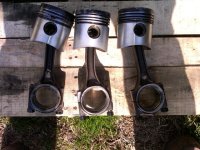Vern,
I would like you to please pay close attention to the ring grooves in #2 piston the ring groove clearance and condition of them is critical to ring sealing.
edit: I know you know this but just saying it to be thinking out loud at the risk of sounding redundant but I mark my rods and caps
in the engine with a paint marker or a scribe. And I do it on one side near the parting line. IE: Id mark 1-3 and once I have them out put the caps back on and make permanent marks so they dont get mixed up or mis-oriented, front is critical position to know also.

If there happens to be a broken ring that almost 100% of the time ruins the piston. Because the pieces floating around with no tension on them wear the grooves something terrible also wears the cyl walls excessively, you will see a deeper ridge is an indication of that. DO NOT CLEAN THE PISTONS WITH A BENCH GRINDER WIRE BRUSH do it with solvent and a scraper and bust a ring and clean the carbon out of the grooves with that if you dont have a ring groove cleaner.
The statement I made earlier about having bad valves wearing grooves applies the same way. The grooves will undoubtedly be worn out if the engine has ran a long time with bad valves its hard to describe why so I wont go into it now.
Take #1 and #3 and measure their grooves with old rings installed and write all that down and do #2 but what we are doing is comparing known good cylinders to a known bad one and
gathering facts. looking for at most .001-.002" they need to be pretty tight but still able to move.
Measure the skirts also at right angles to the pin and about 1" above the very bottom of the piston and write that down. Once you have the specs we can compare them to the book so let me know.
If all are the same I see no reason they cant be re-used unless the skirts are too worn but lets wait and see I have my suspicions. oh btw look for cracks in the skirts and around the ring grooves leading to the pin bore etc look careful. have fun

